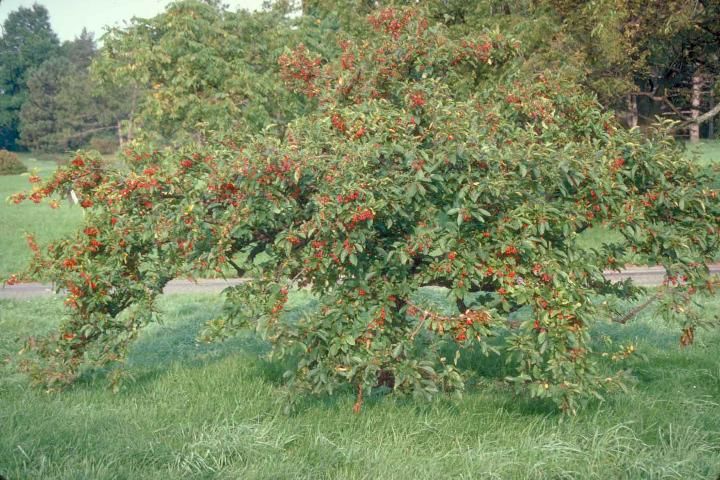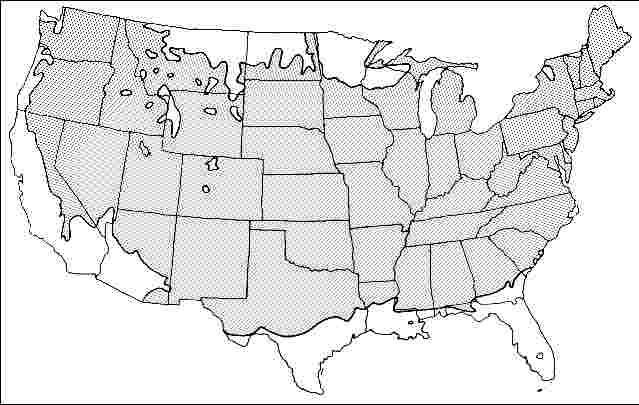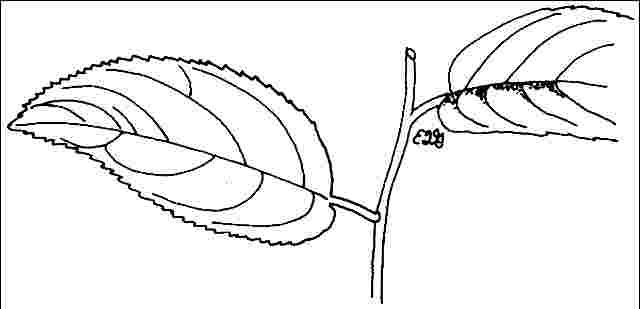Introduction
Sargent crabapple is a dwarf, deciduous tree, forming a dense, wide-spreading, irregularly-rounded silhouette, six to eight feet high by 8 to 10 feet wide. The small, fragrant, springtime blossoms start out as red or pink buds but open to sparkling white flowers. The small, dark red, persistent fruits that follow are extremely popular with birds and other wildlife. They can create a litter problem beneath the canopy as the fruit droops in fall and winter.

Credit: Ed Gilman, UF/IFAS
General Information
Scientific name: Malus sargentii
Pronunciation: MAY-lus sar-JEN-tee-eye
Common name(s): Sargent crabapple
Family: Rosaceae
USDA hardiness zones: 4A through 8A (Fig. 2)
Origin: not native to North America
Invasive potential: little invasive potential
Uses: espalier; specimen; screen; container or planter; trained as a standard; bonsai
Availability: not native to North America

Description
Height: 6 to 12 feet
Spread: 8 to 15 feet
Crown uniformity: irregular
Crown shape: round, vase, spreading
Crown density: dense
Growth rate: slow
Texture: medium
Foliage
Leaf arrangement: alternate (Fig. 3)
Leaf type: simple
Leaf margin: serrate
Leaf shape: elliptic (oval)
Leaf venation: pinnate, brachidodrome
Leaf type and persistence: deciduous
Leaf blade length: 2 to 4 inches
Leaf color: green
Fall color: yellow, orange
Fall characteristic: not showy

Flower
Flower color: white/cream/gray
Flower characteristics: very showy
Fruit
Fruit shape: round
Fruit length: less than .5 inch
Fruit covering: fleshy
Fruit color: red
Fruit characteristics: attracts birds; showy; fruit/leaves not a litter problem
Trunk and Branches
Trunk/bark/branches: branches droop; showy; typically multi-trunked; thorns
Pruning requirement: little required
Breakage: resistant
Current year twig color: brown
Current year twig thickness: thin, medium
Wood specific gravity: unknown
Culture
Light requirement: full sun
Soil tolerances: clay; sand; loam; acidic; alkaline; well-drained; occasionally wet
Drought tolerance: moderate
Aerosol salt tolerance: low
Other
Roots: not a problem
Winter interest: no
Outstanding tree: yes
Ozone sensitivity: sensitive
Verticillium wilt susceptibility: resistant
Pest resistance: resistant to pests/diseases
Use and Management
This dense, compact spreading shrub or small tree makes an outstanding specimen around a residential or commercial landscape. It can be purchased as a single or multi-trunked tree. Select a single-trunked tree for street and parking lot locations. It looks great growing out of a low groundcover, located in a bed with low-growing shrubs, or placed toward the rear of a shrub border. A row would make a nice screen during the summer months.
Sargent crabapple grows in moist, well-drained, acid soil in full sun locations for best flowering and disease resistance. They are not recommended for sandy soil due to their inability to tolerate drought, but any other soil is suitable, including clay. Unlike many other crabapples, sargent crabapple is only slightly susceptible to scab, fireblight, and leaf spot. This makes it one of the best for the South. Crabapples grow well in the Texas panhandle but are not extremely drought tolerant and are not well suited for high pH soil.
Contact the Ornamental Crabapple Society, Morton Arboretum, Lisle, Illinois 60532 for more information on crabapples.
Pests
Aphids infest branch tips and suck plant juices.
Fall webworm makes nests on the branches and feeds inside the nest. Small nests can be pruned out or sprayed with Bacillus thuringiensis.
Scales of various types are usually controlled with horticultural oil.
Mites are too small to see easily so can cause much foliage discoloration before being detected. Mites are usually controlled with horticultural oil.
Tent caterpillar builds tents or nests in trees in early summer or late spring. Feeding occurs outside the nest. Small nests are pruned out or simply pulled from the tree and caterpillars crushed. Spray with Bacillus thuringiensis. Do not burn nests while they are still in the tree since this injures the tree and could start an uncontrolled fire.
Diseases
Sargent crabapple shows good disease-resistance.
Scab infection takes place early in the season and dark olive green spots appear on the leaves. In late summer the infected leaves fall off when they turn yellow with black, spots. Infected fruits have black, slightly raised spots. Use resistant varieties.
Fire blight susceptible trees have blighted branch tips. Leaves on infected branch tips turn brown or black, droop, and hang on the branches. The leaves look scorched as by a fire. The trunk and main branches become infected when the bacteria are washed down the branches. Cankers form and are separated from adjacent healthy bark by a crack. The infected bark may be shredded. Use resistant cultivars when available.
Powdery mildew is a fungus which coats leaves with mycelia resembling white powder.
Rust causes brown to rusty-orange spots on the leaves. Badly spotted leaves fall prematurely. Redcedars are the alternate host.
Crabapples are subject to several canker diseases. Prune out infected branches, avoid unnecessary wounding, and keep trees healthy.